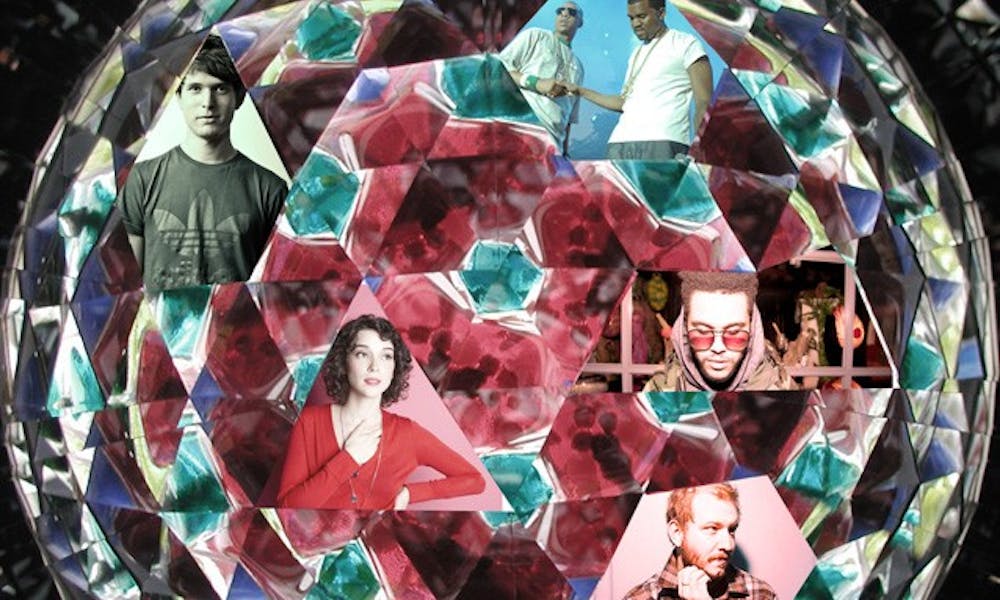The first time I heard of Edward Albee’s 1962 play Who’s Afraid of Virginia Woolf? was in my 11th grade American Literature class. I recall thumbing through an enormous packet of contemporary American plays our teacher had compiled for us to choose and act out, breezing by lighthearted, accessible farces (i.e., Clare Boothe Luce’s The Women, a Mean Girls of the 1930s—the drama I ultimately chose) to puzzle over the absurd plotlines and characters of writers like Edward Albee. I flipped between descriptions of three of his plays—The Zoo Story, The American Dream and Who’s Afraid of Virginia Woolf?—longing to see their weirdness and dysfunction come to fruition within my classroom’s 10 by 10-foot performance space.
After attending Playmakers Repertory Company’s production of Who’s Afraid of Virginia Woolf? last weekend, I’m glad, even as a self-serious, Holden Caulfield-esque high school junior, I didn’t attempt the three-part drama, which raises issues that can only be tackled by those with a bit of experience under their belt. Playmakers’ adaptation utilizes Albee’s humor and critical eye to highlight the play’s fundamental tension: while transpiring over the course of a single evening with just four characters and one set, the drama—which clocks in at just under three hours—feels more like a physical and emotional marathon than an evening of, as the title of Act One suggests, “Fun and Games.”
It becomes clear immediately that George and Martha, masterfully acted by Playmakers veterans Ray Dooley and Julie Fishell, are gamesters at heart, using verbal exercises to unveil a shared perceptiveness that is equally damaging and illuminating. A middle-aged couple, they live at an unnamed New England college where George is a history professor and Martha’s father is the president. Leaving one of the college’s swinging “Saturday night orgies,” the two decamp to their sprawling old house to further entertain Nick (Brett Bolton), a biology professor, and Honey (Katie Paxton), a younger Midwestern couple who are newbies at the college. The evening unfolds in two further acts, “Walpurgisnacht” and “The Exorcism,” as George and Martha man the household until dawn breaks, boozing their guests and alternately mining and exposing information that both they and Nick and Honey have kept hidden.
The play’s success, both in a literary and theatrical sense (and specifically in this production) comes through in each character’s ability to run with Albee’s witty verbal composition. Relying on puns and a bevy of both literary and historical references, George and Martha seem like amped-up, alcoholic, younger versions of your cultured grandparents who read The New Yorker voraciously and finish the Sunday crossword with comedic anecdotes accompanying each word. The couple’s bond—sickening and disastrous but, above all, mutually reinforcing—works to progressively overpower Nick and Honey’s reliance on politeness and naïvete, and the generational gap between the two pairs further emphasizes their character differences.
As Dooley and Fishell feed off of each other, allowing their peculiar chemistry to reveal itself and in turn mold them into the dynamos that are George and Martha, they bring out the play’s undergirding consideration of physicality and intellect. The couple moves around in relation to their household objects—a multi-floor library, discarded Life magazines, a well-stocked liquor shelf—spouting phrases like “a Dylan Thomas-y quality” and “a quietly noisy relaxed intensity” to describe an Abstract Expressionist painting propped on an easel. While the credit here goes to Alexander Dodge, the scenic designer, Dooley and Fishell do well situating themselves in terms of the physical weight of academia their characters have accrued over the years. They command the space, moving in transfixing floor patterns to and from the alcohol, up the spiral staircase to change clothing and unleash sexual desire, off of Playmakers’ thrust stage only to re-emerge with a rifle that spouts a toy umbrella. As they kid Nick and Honey into submission, speaking of ambition, performance, truth and illusion, they own the stage even as they reveal vulnerability in their physical and intellectual command. Surrounded by an interior design that reflects both their history as a couple and their entrenchment in college politics, George and Martha use their home-court advantage to expand big questions beyond the domestic sphere. Commendable but unremarkable, Bolton and Paxton’s Nick and Honey flitter in and out, lacking some of the moral weight and frightening quirkiness of their counterparts in the Oscar-winning 1966 film adaptation of Albee’s play.
Embodied currently by Dooley and Fishell, George and Martha are a couple that could inhabit Simon and Garfunkel’s 1966 song “The Dangling Conversation,” but they would probably scream rather than meekly ask questions such as “Can analysis be worthwhile?” and throw volumes of Emily Dickinson and Robert Frost at each other rather than read them in separate quarters silently. In Playmakers’ Who’s Afraid of Virginia Woolf?, Dooley and Fishell demonstrate how Albee’s George and Martha transcend literary form, simultaneously trapped and liberated by their questions regarding how the body and mind can interact to craft a fearless, illusionless, nonfictional way of living.
Playmakers’ production of Who’s Afraid of Virginia Woolf? will run through December 18 at the Center for Dramatic Art at UNC-Chapel Hill.
Get The Chronicle straight to your inbox
Signup for our weekly newsletter. Cancel at any time.

